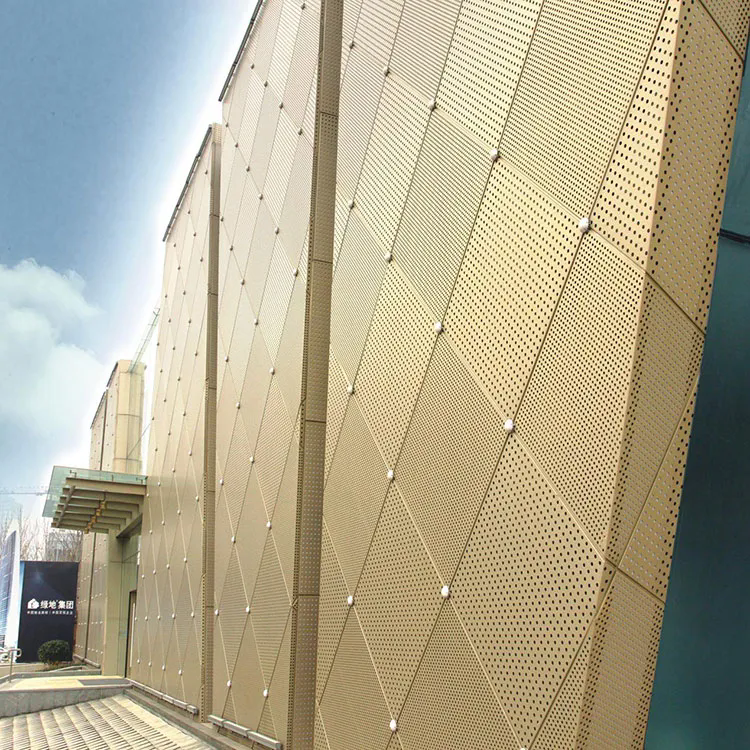- English
- Español
- Português
- русский
- Français
- 日本語
- Deutsch
- tiếng Việt
- Italiano
- Nederlands
- ภาษาไทย
- Polski
- 한국어
- Svenska
- magyar
- Malay
- বাংলা ভাষার
- Dansk
- Suomi
- हिन्दी
- Pilipino
- Türkçe
- Gaeilge
- العربية
- Indonesia
- Norsk
- تمل
- český
- ελληνικά
- український
- Javanese
- فارسی
- தமிழ்
- తెలుగు
- नेपाली
- Burmese
- български
- ລາວ
- Latine
- Қазақша
- Euskal
- Azərbaycan
- Slovenský jazyk
- Македонски
- Lietuvos
- Eesti Keel
- Română
- Slovenski
What Is Aluminum Wall Cladding?
Aluminum wall cladding is a popular architectural solution used to enhance the appearance and durability of building exteriors. This material combines the aesthetic appeal of metal with practical benefits, making it a versatile choice for both residential and commercial applications. In this blog, we’ll explore what aluminum wall cladding is, its benefits, and how it can be used in various settings.

What Is Aluminum Wall Cladding Made Of?
Aluminum wall cladding is composed of thin aluminum panels or sheets that are attached to the exterior of a building. These panels are often made from high-quality aluminum alloys that provide a balance of strength, lightness, and resistance to environmental factors. The aluminum is typically coated with a protective finish, such as powder coating or anodizing, to enhance its durability and aesthetic appeal.
How Does Aluminum Wall Cladding Improve Building Aesthetics?
Aluminum wall cladding can significantly enhance the visual appeal of a building. It offers a sleek, modern look with a range of finishes, colors, and textures. The versatility of aluminum allows for creative design options, including smooth surfaces, metallic sheens, and custom patterns. This aesthetic flexibility makes aluminum cladding an attractive choice for both contemporary and traditional architectural styles.
What Are the Benefits of Using Aluminum Wall Cladding?
Aluminum wall cladding offers several advantages, including:
Durability: Aluminum is resistant to corrosion, weathering, and UV rays, ensuring long-lasting performance in various climates.
Low Maintenance: The material requires minimal upkeep, as it does not rust or rot and can be easily cleaned.
Lightweight: Aluminum panels are lightweight, making them easier to handle and install compared to heavier materials.
Energy Efficiency: Some aluminum cladding systems include insulating layers that contribute to improved energy efficiency by reducing heat loss or gain.
How Is Aluminum Wall Cladding Installed?
The installation of aluminum wall cladding involves several steps:
Preparation: The building surface is cleaned and prepared to ensure proper adhesion of the cladding panels.
Framework: A framework or support system is installed to provide a secure base for attaching the aluminum panels.
Panel Attachment: Aluminum panels are fixed to the framework using screws, clips, or adhesive. The panels are often interlocked or overlapped to create a seamless appearance.
Finishing Touches: Seams and joints are sealed, and any additional elements, such as trim or edge profiles, are added to complete the installation.
Can Aluminum Wall Cladding Be Used for Both Residential and Commercial Buildings?
Yes, aluminum wall cladding is suitable for both residential and commercial buildings. Its versatility and range of design options make it an ideal choice for various applications, including office buildings, shopping centers, apartment complexes, and private homes. The material’s durability and low maintenance requirements also make it well-suited for high-traffic areas and challenging environmental conditions.
What Are the Environmental Benefits of Aluminum Wall Cladding?
Aluminum is a highly sustainable material with several environmental benefits:
Recyclability: Aluminum can be recycled indefinitely without losing its quality, reducing the need for raw material extraction and minimizing waste.
Energy Efficiency: The insulating properties of some aluminum cladding systems can help reduce energy consumption by improving a building’s thermal performance.
Longevity: The durability of aluminum reduces the need for frequent replacements, contributing to lower environmental impact over the material’s lifespan.
How Does Aluminum Wall Cladding Compare to Other Cladding Materials?
Compared to other cladding materials, aluminum offers unique advantages:
Weight: Aluminum is lighter than materials like stone or concrete, making it easier to handle and install.
Durability: It outperforms some materials in terms of resistance to corrosion and weathering.
Maintenance: Aluminum requires less maintenance compared to wood or vinyl cladding, which may need regular painting or sealing.
Are There Any Drawbacks to Using Aluminum Wall Cladding?
While aluminum wall cladding has many benefits, there are a few considerations to keep in mind:
Cost: High-quality aluminum cladding can be more expensive than some other materials, although its durability and low maintenance can offset the initial investment.
Denting: Although durable, aluminum can be susceptible to denting from impacts, so careful handling and installation are essential.
Aluminum wall cladding is a versatile and practical choice for enhancing the appearance and performance of building exteriors. Its durability, low maintenance, and aesthetic flexibility make it suitable for a wide range of applications. Whether you’re looking to update the look of your home or design a modern commercial building, aluminum wall cladding offers a reliable and stylish solution that stands the test of time.
Foshan Zhengguang Aluminum Technology Co. , Ltd. is a company that specializes in providing quality Aluminum Wall Cladding to clients worldwide. Visit our website at https://www.zgmetalceiling.com/ to learn more about our products.




